Such a brilliant idea: a Blessing of the Backpacks. I first encountered it in Full-Week Faith, created by Karen Bellavance Grace through the Fahs Collaborative, which is ” is an exciting laboratory that brings people together to explore and create innovative ways to deepen faith through educational encounters.”
There are many reasons to do this. As part of that innovative re-visioning of faith formation, such an event would help congregations remember commitments made at child dedications, as well as connecting our UU principle of the “free and responsible search for truth and meaning” as a thing we not just inside the walls of the church, but outside them as well.

Full-Week Faith (FWF) envisions this ritual as part of a larger effort that works on many levels, including intentional outreach via letters and social media contacts to young adults so they feel connected to the congregation, growing a tutoring program that connects elders in the congregation with youth afterschool, and a host of other possibilities – bringing out faith out of Sunday morning and into the WHOLE week.
Though FWF recommends this ritual take place as part of Sunday worship, the congregation where I am currently the Intern Minister wanted to do it a little differently. Like many Unitarian Universalist congregations, we hold lay-led Sunday services in the summer. Though children are welcome, they are rarely present. Our big Ingathering, “first” service of the year takes place the Sunday after Labor Day. This means that if we were going to bless backpacks before the start of the church year, we would need to create an event just for this purpose.
Many people played important roles in making this happen, though it was just a handful in the conceptualization stage, and a few more added on in the last few weeks. Since this took place at the end of the summer, we were fortunate that people were around to be able to give of their time. A big shout out to everyone from start to finish who helped make this moment in our church life possible! Thank you thank you thank you.
Here is a description of our process in creating this, just in case you are considering doing something like this and don’t want to reinvent the wheel.
Choosing a Date & Time After identifying when school would start in our locale, we then decided that we should not do it the night before school starts – likely too stressful for families. So we scheduled it for two nights before.
Since we are talking about including families with school age kids, including the littlest ones, it would have to be early evening, since some Littlests go to be early-pearly. Knowing that the ritual and the whole event would need to match the attention spans of kiddles and of families, we settled on starting at 4:45 and planned to be done by 6:00.
Outreach The Religious Education Committee had discussed it as one of their agenda items at their meeting in June. The Intern Minister (that’s me) created a Facebook event; typically this congregation has not used the Facebook event function for church activities. So this was an experiment. Facebook events must be either private (by invitation only) or public (the whole world can know about it). We choose “public,” even though our outreach would focus on our congregants. Though this is something we may want to grow to welcome the whole town/wider community or other UU congregations, we thought we would start just with us to see how it went and to gauge whether it had any traction.
We reached out to several key members in the congregation who had 1) a Facebook practice and 2) had some social sway (by which I mean that they were connected to other families in the congregation and if they posted something on their Facebook profile, others in the congregation would likely see it and have a positive feel towards it). We asked them to talk up the event, including posting it on their Wall once a week in the few weeks leading up to it. In the last two weeks, we created more activity on Facebook around the event – on the event page itself, posting it to pages of the congregation, the Minister, and the Intern Minister. Not only did this create energy around the event, it helped inform those who had not already seen it and it helped remind those who had.
 For the FB event page, we borrowed an attractive image from the internet that was made for this purpose (this ritual, it turns out, is a thing – many churches do it and have created graphics around it). It’s a wonderful graphic. I wish I knew who created it so I can give attribution. We know that best practices in social media includes use of appealing visuals. It makes a difference as to whether people will pay initial attention.
For the FB event page, we borrowed an attractive image from the internet that was made for this purpose (this ritual, it turns out, is a thing – many churches do it and have created graphics around it). It’s a wonderful graphic. I wish I knew who created it so I can give attribution. We know that best practices in social media includes use of appealing visuals. It makes a difference as to whether people will pay initial attention.
What turned out to be far more attractive that that wonderful image was som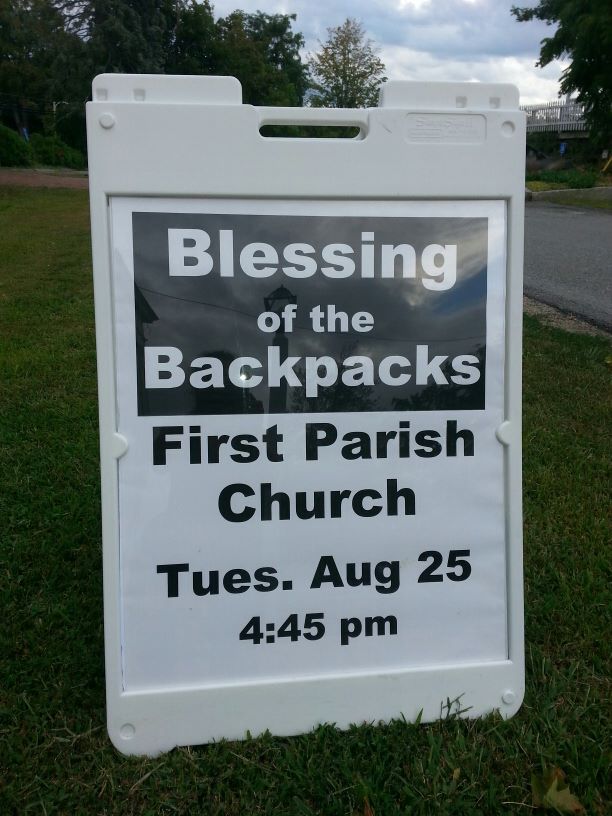 ething we did not plan. It came from the synergy of the congregation. Our church is in the middle of this old New England down. Seriously: right in the middle. We have a relatively new sandwich board sign that sits on Main Street when we have special events. Bless whoever is in charge of it, because they created a sign announcing to the whole wide town our event (we didn’t think of this and didn’t ask them to do this – they just came to the idea on their own). Then, they took a photo to share. We posted that photo on our congregation’s Facebook page (so then, it went out to the whole wide world). Imagine our surprise when Facebook’s analytics reported that the photo had over 1,700 views! In addition, we have observed numerous UU individuals around the country asking their communities, “Isn’t this cool?” and “Can we do this at our church??”
ething we did not plan. It came from the synergy of the congregation. Our church is in the middle of this old New England down. Seriously: right in the middle. We have a relatively new sandwich board sign that sits on Main Street when we have special events. Bless whoever is in charge of it, because they created a sign announcing to the whole wide town our event (we didn’t think of this and didn’t ask them to do this – they just came to the idea on their own). Then, they took a photo to share. We posted that photo on our congregation’s Facebook page (so then, it went out to the whole wide world). Imagine our surprise when Facebook’s analytics reported that the photo had over 1,700 views! In addition, we have observed numerous UU individuals around the country asking their communities, “Isn’t this cool?” and “Can we do this at our church??”
Before the Ritual While families were arriving and folks were jus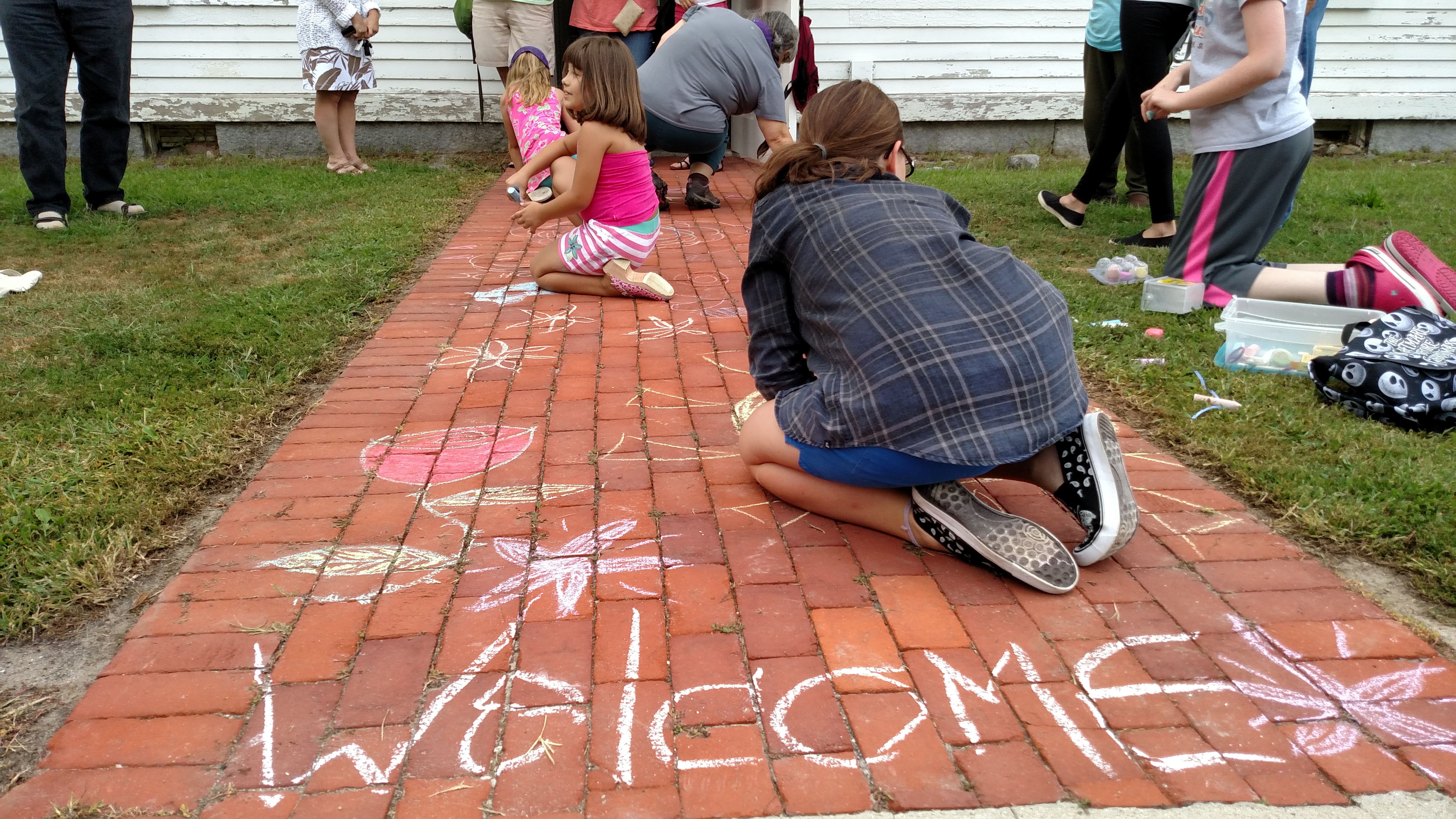 t hanging about, waiting for it to start, we provided sidewalk chalk and encourage anyone – but especially kids – to drawn on our brick walkway. This gave a focus for those gathered and a way for awkward energies to be channeled. As well as whose spirits aren’t lifted when they see whimsical, joyful drawing by children?
t hanging about, waiting for it to start, we provided sidewalk chalk and encourage anyone – but especially kids – to drawn on our brick walkway. This gave a focus for those gathered and a way for awkward energies to be channeled. As well as whose spirits aren’t lifted when they see whimsical, joyful drawing by children?
Highlight Youth The service began, like any good UU service, by lighting the chalice. After that, we then marked the end of the summer by singing a camp song. We chose an interactive, “repeat-after-me” song. We chose Boom Chicka Boom, which is silly and has multiple verses that are fun to enact. Children were invited to help lead the song if they knew it. Delightful and unplanned is that some of the older kids who came forward to help lead knew verses the Intern Minister didn’t and, in fact, ended up leading the song — way more fun.
Our congregation is structured so that we have Coming of Age every other year. This year is one of those years. At that June meeting, we identified that we hoped that this Blessing event would provide an opportunity for the Coming of Agers to participate and begin to identify as such. We did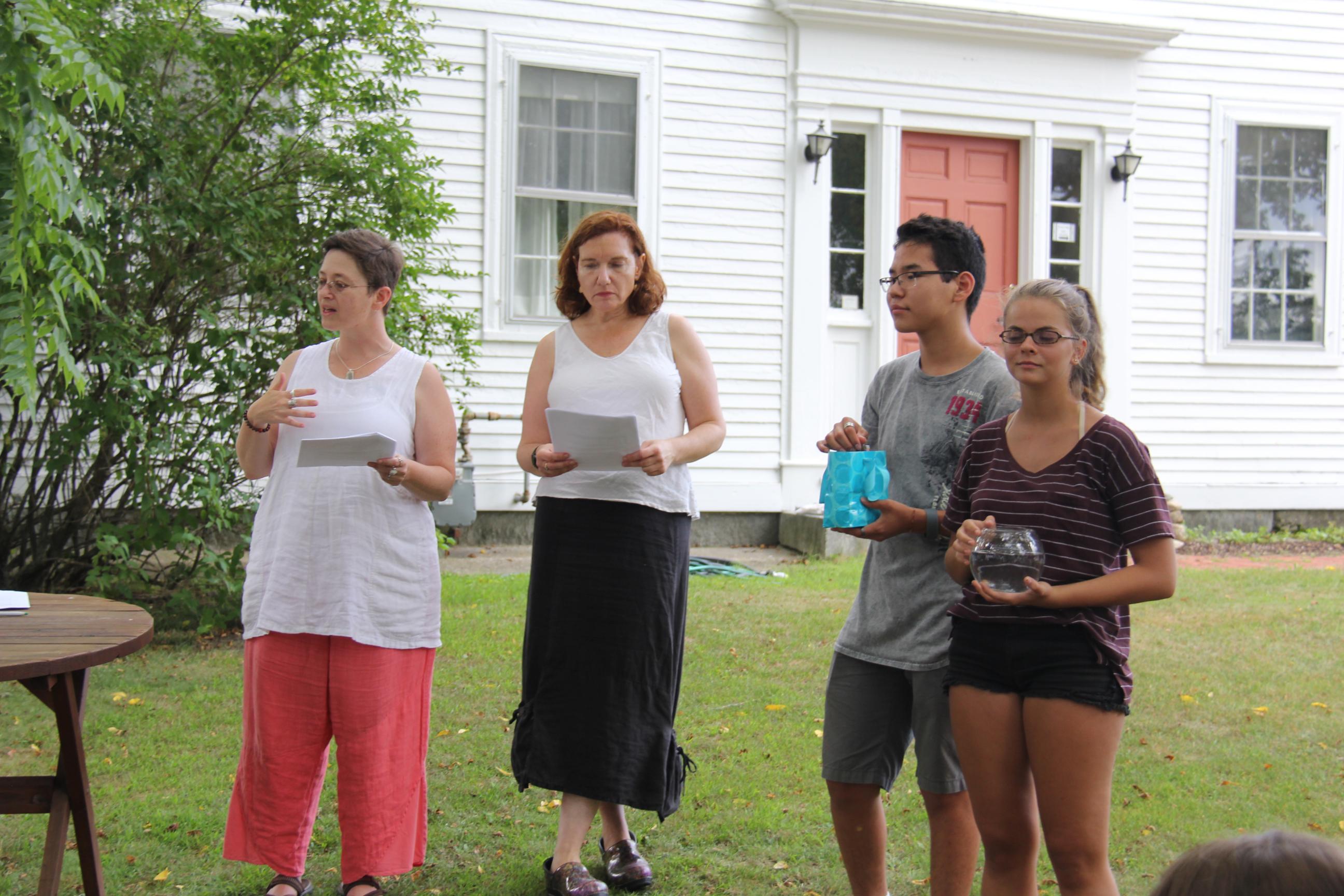 not know how many COA’ers would attend, so we wrote the liturgy to bless them first (and to remove that part if none of them showed up), then have their role to be the giver of the blessing to the rest of the participants.
not know how many COA’ers would attend, so we wrote the liturgy to bless them first (and to remove that part if none of them showed up), then have their role to be the giver of the blessing to the rest of the participants.
Much to our joy, two COA’ers were there and joyfully took part. Their facilitation of the liturgical elements (talismans, holy water) was powerful for the younger kids who could see youth in important, serious roles and for the adults for that same reason.
We ended the whole service with a song sung by three of our older youths – this was organized only in the final few days before the ritual took place. In fact, the youth decided which song to sing (with final approval from adult organizers). It was a lovely choice: Seasons of Love.

Inclusive Language We were sure to use inclusive language regarding educational choices – since we were using school as a reference (“school is just about to start”) we were sure to reference those who are homeschooling. We also decided that to invite as much multi-generational participation as possible, we would also include the School of Life – thus making it clear that anyone could receive a blessing if they were so moved. Finally, since we invited folks to bring their backpacks (empty), we were sure to do two things: normalize if someone forgot to bring their backpack (we spoke of “invisible backpacks”), as well as to let folks interpret “backpack” to mean most anything. On Facebook and in person, people asked if they could have their briefcase, their wallet, their cell phone, their purse, the bag that holds their sheet music, and so on blessed.
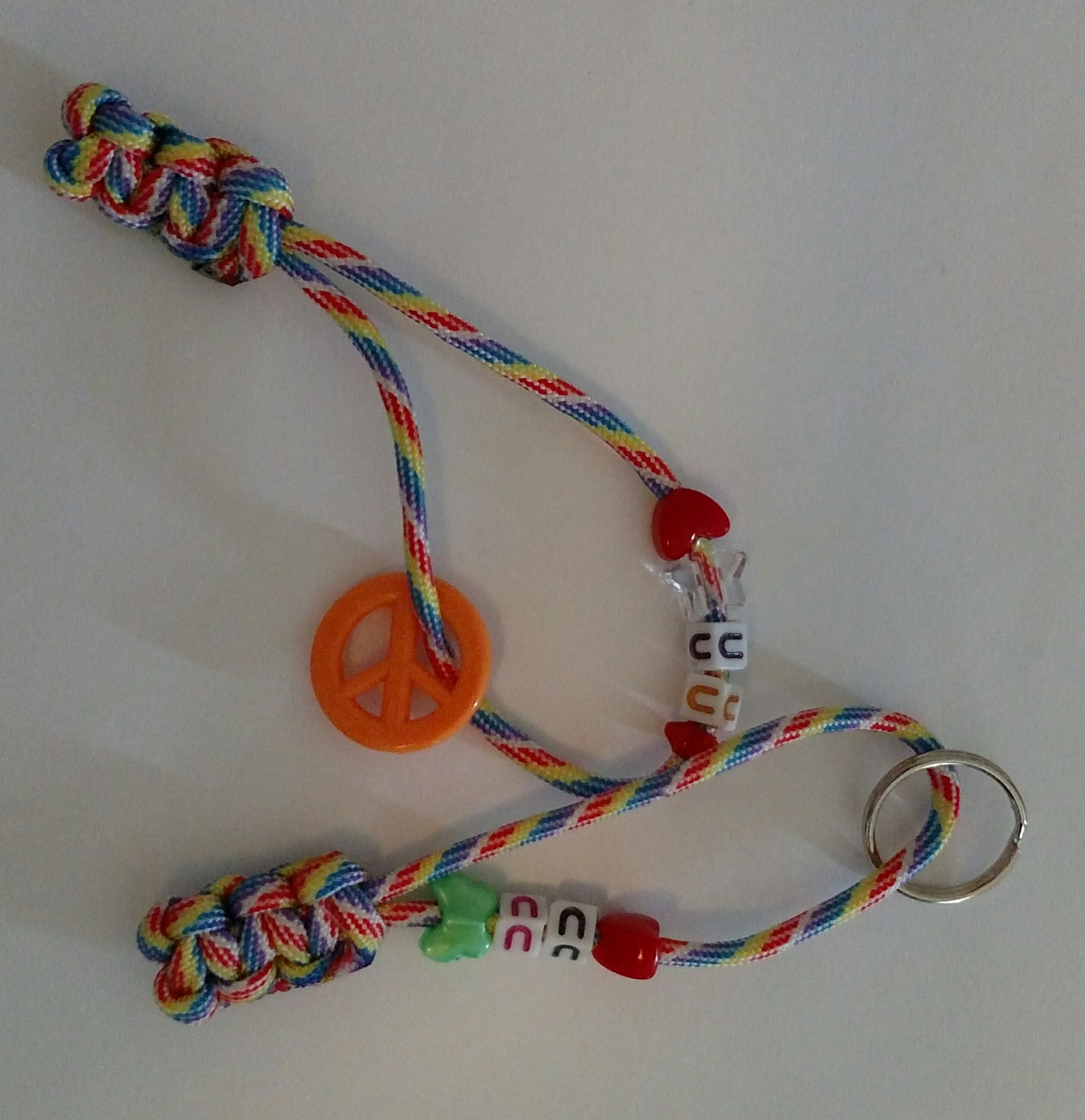 The Ritual The actual ritual included words and blessing elements of water and the giving of a material reminder of the blessing in the form of talismans made for this occasion. The talismans, created by one of the members of the congregation and the Director of Religious Education together, were so delightful, combining symbols of peace, or beads that said “UU” or the name of our church (the congregation’s initials, “FPCOG”). They were colorful and put on a key chain so that they could be attached to the backpacks.
The Ritual The actual ritual included words and blessing elements of water and the giving of a material reminder of the blessing in the form of talismans made for this occasion. The talismans, created by one of the members of the congregation and the Director of Religious Education together, were so delightful, combining symbols of peace, or beads that said “UU” or the name of our church (the congregation’s initials, “FPCOG”). They were colorful and put on a key chain so that they could be attached to the backpacks.
We blessed the Coming of Agers, then students of any age, then teachers, then anyone who hadn’t yet been blessed (those students of life). One of the ministers spoke these words (more or less – adapted a bit to each group) to each of the called groups:
Even when you are away from First Parish, you carry the heart of Unitarian Universalism with you wherever you go.
May you feel curiosity all your days.
May your imagination catch fire.
May you find courage when it is necessary.
May confusion lead to better questions.
May you feel compassion toward those around you, and they towards you.
May you feel heard and seen; may you hear and see others.
May you speak up for those who are not heard, who are not seen.
As your spirit’s home, we are made stronger when you share what you learn. We ask you to bring what you learn of the world back to this place. If you agree, say – “we will.”
Then the Coming of Agers dipped the talisman in a bowl filled with the holy water (created from last year’s Water Communion and used throughout the whole year for special occasions), then handed the talisman to each person who had lined up to receive the blessing. As they moved through a line, the other minister gave a water blessing to the backpack (or wallet, or purse, or bag, or shoulder).
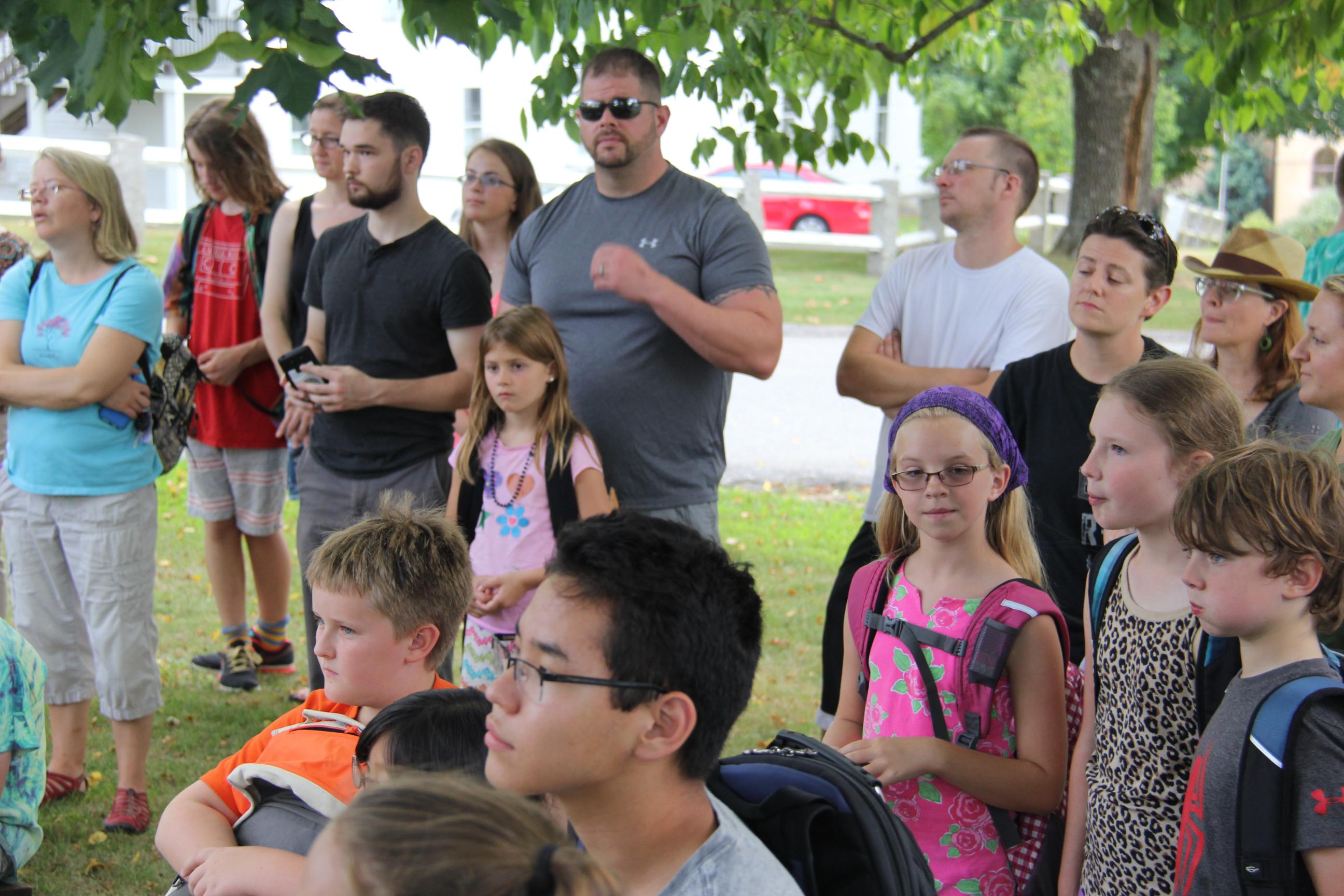
A short benediction was offered, then we broke bread (which is to say, we ate pizza and brownies) together.

You are welcome and highly encouraged to borrow any part of this – no need to feel loyal to the words we used or the particular flow of the ritual. Change it up. Mix and match. Make it your own. Take one element, take no elements, take all the elements and rearrange them to suit you, or use it as a whole cloth. It’s up to you. My only request is that if you are going to use the words of our blessing in their current form and use them in print (hard copy or online) that you attribute them to me.
If you do a ritual like this and you have found this post helpful, please let me know by commenting below. It would be great to hear how this works out in other places.